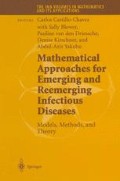Abstract
A mathematical model for the transmission dynamics of Schistosomiasis japonicum is derived. The model consists of a system of retarded functional differential equations to take into account two important factors of the transmission process of this disease, i.e., the transit-time distribution and multiple definitive hosts (both human and non-human). The strong monotonicity principle recently established by Wu is used to show that the solution of our model equations defines an eventually strongly monotone semifiow which allows us to give a rather complete qualitative description of the global dynamics of the model.
Access this chapter
Tax calculation will be finalised at checkout
Purchases are for personal use only
Preview
Unable to display preview. Download preview PDF.
References
Bradley, J. and May, R.M., Consequences of helminth aggregation for the dynamics of schistosomiasis, Trans. Roy. Soc. Trop. Med. Hyg. 72: 262–273, 1978.
Bowles, J., Blair, D., and McManus, D.P., A molecular phylogeny of the human schistosomes, Molec. Phylogen. and Evolut. 4(2): 103–109, 1995.
Hagan, P. and Gryseels, B., Schistosomiasis research and the European Community, Tropic. and Geogr. Medic. 46(4):259–268, 1994.
Hale, J.K. and Kato, J., Phase space for retarded equations with infinite delay, Funkcialaj Ekvac. 21: 11–41, 1978.
He, Y., Xu, S., Shi, F., Shen, W., Hus, S., and Hsu, H., Comparative studies on the infection and maturation of Schistosoma japonicum in cattle and buffaloes, Acta Zool. Sinica 38(3): 266–271, 1992.
Hirschm M.W., The dynamical systems approach to differential equations, Bull. Amer. Math. Soc. 11: 1–64, 1984.
Hirschm M.W., Systems of differential equations that are competitive or cooperative II: Convergence almost everywhere, SIAM J. Math. Anal. 16: 423–439, 1985.
Hirschm M.W., Stability and convergence in strongly monotone dynamical systems, J. Reine Angew Math. 383: 1–53, 1988.
Lee, K.L. and Lewis, E.R., Delay time models of population dynamics with application to schistosomiasis control, IEEE Trans. Biomed. Eng. BME-23: 225–233, 1976.
Lewis, T., A model for the parasitic disease bilharziasis, Adv. Appl. Probab. 7: 673–704, 1975.
MacDonald, G., The dynamics of helminth infections, with special reference to schistosomes, Trans. R. Soc. Trop. Med. Hyg. 59: 489–506, 1965.
MacDonald, G., On thee Scientific basis of tropical hygiene, Trans. R. Soc. Trop. Med. Hyg. 59: 611–620, 1965.
Matano, H., Asymptotic behavior and stability of solutions of semilinear diffusion equations, Publ. Res. Inst. Math. Sci., 15: 401–454, 1979.
Matano, H., Existence of nontrivial unstable sets for equilibrium of strongly order-preserving systems, J. Fac. Sci. Univ. Tokyo, Sec. t-lA Math. 30: 645–673, 1983.
Matano, H., Strongly order-preserving local semi-dynamical systems — theory and applications, Proceedings of Autumn Course on Semigroups, Pitman, New York, 1985.
May, R.M., Togetherness among schistosomes, its effects on the dynamics of the infection, Math. Biosci. 35: 301–343, 1977.
Naito, T., Integral manifolds for linear functional differential equations on some Banach space, Funkcialoj Ekvac. 13: 199–213.
Naito, T., On linear autonomous retarded equations with an abstract space for infinite delay, J. Differential Equations 33: 74–91, 1979.
Naito, T., On autonomous linear functional differential equations with infinite retardations, J. Differential Equations 2: 297–315, 1976.
Nasell, I., A hybrid model of schistosomiasia with snail latency, Theor. Popul. Biol. 10: 47–69, 1976.
Nasell, I., On eradication of schistosomiasis, Theor. Popul. Biol. 10: 133–144, 1976.
Nasell, I. and Hirsch, W.M., A mathematical model of some helminthic infections, Comm. Pure Appl. Math. 25: 459–477, 1972.
Nasell, I. and Hirsch, W.M., The transmission dynamics of schistosomiasis, Comm. Pure Appl. Math. 26: 395–453, 1973.
Nussbaum, R., The radius of the essential spectrum, Duke Math. J. 37: 473–488, 1970.
Nussbaum, R., Positive operators and elliptic eigenvalue problems, Math. Zeit. 186: 247–269, 1984.
Nussbaum, R., A folk theorem in the spectral theory of co-semigroups, Pac. J. Math. 113: 433–449, 1984.
Nussbaum, R., Hilbert’s Projective Metric and Iterated Nonlinear Maps, Mem. Amer. Math. Soc. 391, 1988.
Shi, Y., Jiang, C., Han, J., Li, Y., and Ruppel, A., Immunization of pigs against infection with Schistosoma japonicum using ultraviolet-attenuated cercaria, Parasitology 106(5): 459–462, 1993.
Smith, H., Periodic solutions of periodic competitive and cooperative systems, SIAM J. Math. Anal. 17: 1289–1318, 1986.
Smith, H., Invariant curves for mappings, SIAM J. Math. Anal. 17: 1053–1067, 1986.
Smith, H., Monotoe semiflows generated by functional differential equations, J. Differential Equations 66: 420–442, 1987.
Wu, J., Liu, N., and Zuo, S., The qualitative analysis of model of the transmission dynamics of Japaneses schistosomiasis, Applied Mathematics, a Journal of Chinese Universities 2: 352–362, 1987.
Wu, J., Strong monotonicity principles and applications to Volterra integrodifferential equations, Differential Equations: Stability and Control, Saber, ed., Marcel Dekker, 1990.
Wu, Z., Bu, K., Yuan, L., Yang, G., Zhu, Z., and Liu, Q., Factors contributing to reinfection with schistosomiasis japonica after treatment in the lake region of China, Acta Tropica 52(2): 83–88, 1993.
Author information
Authors and Affiliations
Editor information
Editors and Affiliations
Rights and permissions
Copyright information
© 2002 Springer Science+Business Media New York
About this paper
Cite this paper
Wu, J., Feng, Z. (2002). Mathematical Models for Schistosomiasis with Delays and Multiple Definitive Hosts. In: Castillo-Chavez, C., Blower, S., van den Driessche, P., Kirschner, D., Yakubu, AA. (eds) Mathematical Approaches for Emerging and Reemerging Infectious Diseases: Models, Methods, and Theory. The IMA Volumes in Mathematics and its Applications, vol 126. Springer, New York, NY. https://doi.org/10.1007/978-1-4613-0065-6_12
Download citation
DOI: https://doi.org/10.1007/978-1-4613-0065-6_12
Publisher Name: Springer, New York, NY
Print ISBN: 978-1-4612-6550-4
Online ISBN: 978-1-4613-0065-6
eBook Packages: Springer Book Archive

